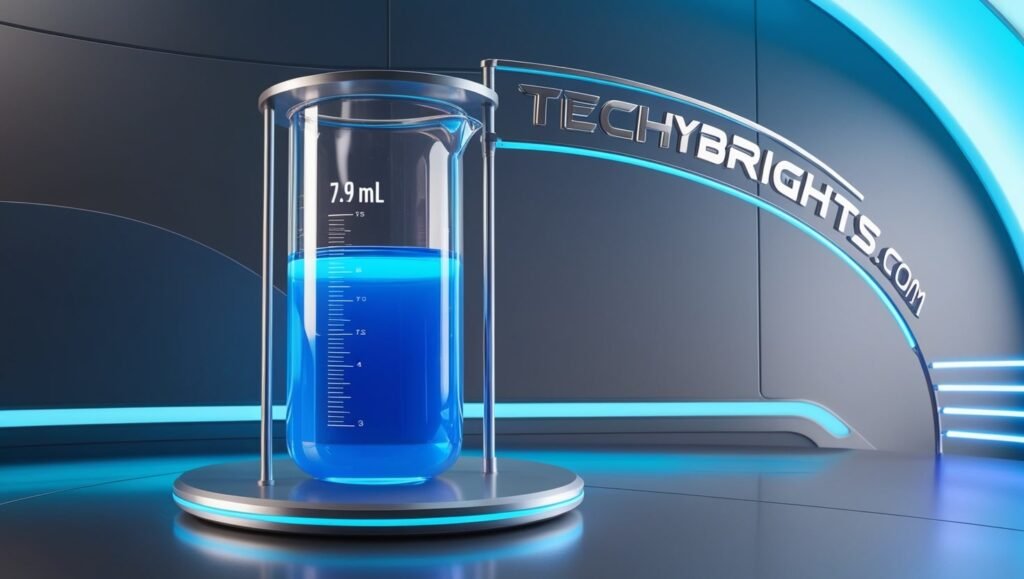In everyday life, we frequently encounter measurements and numbers that are not always in whole numbers. Whether in cooking, science, or daily transactions, rounding numbers is a common practice to simplify calculations and make them easier to understand. One such number that often gets rounded is 7.87 ml. The process of rounding this value to the nearest tenth involves understanding a basic principle in mathematics that helps to make numbers more accessible. But how exactly do you round 7.87 ml rounded to the nearest tenth? Let’s break down this concept, explore the rounding process, and discuss the importance of rounding in different contexts.
What Does Rounding to the Nearest Tenth Mean?
Before we dive into the details of 7.87 ml rounded to the nearest tenth, it’s essential to understand the concept of rounding. Rounding is the process of adjusting a number to a nearby, simpler value that is easier to work with. The “nearest tenth” refers to rounding a number to one decimal place, meaning the number will be rounded to the first digit after the decimal point.
For example, in the case of 7.87 ml, rounding to the nearest tenth means looking at the digit in the hundredths place (the second digit after the decimal point), which is 7. If this digit is 5 or greater, the number in the tenths place (the first digit after the decimal) will be increased by one. If the digit in the hundredths place is less than 5, the digit in the tenths place remains unchanged.

Therefore, 7.87 ml rounded to the nearest tenth becomes 7.9 ml because the number in the hundredths place (7) is greater than 5, so we round up.
The Importance of Rounding in Everyday Life
Understanding how to round numbers, like 7.87 ml rounded to the nearest tenth, is essential in various practical situations. Rounding simplifies complex numbers, making them easier to comprehend and work with. For example, in cooking, when measuring liquids like 7.87 ml, recipes may call for rounded amounts to avoid unnecessary precision. Instead of using a measurement like 7.87 ml, you would use 7.9 ml to make it simpler and quicker to add ingredients.
Similarly, in science, rounding is often used in calculations to express results more clearly. When conducting experiments or analyzing data, scientists use rounding to present their findings in a manner that is easy to interpret. In this case, 7.87 ml rounded to the nearest tenth is more practical than presenting the full number.
Rounding and Its Impact on Accuracy
While rounding simplifies numbers, it also introduces a slight loss of accuracy. When we round 7.87 ml Rounded to the Nearest Tenth, we’re no longer using the exact measurement but rather a rounded approximation. Depending on the context, this loss of precision might not significantly impact the outcome, but in certain fields, such as medicine or engineering, even small rounding can have important consequences.
For example, in the pharmaceutical industry, accurate measurements of liquid substances are critical. A slight difference in dosage, even from 7.87 ml Rounded to the Nearest Tenth, could make a big difference in how effective or safe a medication is. In these cases, rounding to the nearest tenth is not always ideal, and more precision is needed.
On the other hand, in less critical scenarios, such as when measuring ingredients for a recipe or estimating travel time, rounding numbers like 7.87 ml to the nearest tenth is perfectly acceptable and helpful.
How Rounding to the Nearest Tenth Helps in Everyday Tasks
Rounding to the nearest tenth simplifies many everyday tasks, including budgeting, cooking, and estimating distances. For example, when managing household finances, you might have to round amounts such as 7.87 ml to the nearest tenth to ensure that you are staying within budget. Similarly, when measuring liquids for cooking, you can round measurements like 7.87 ml Rounded to the Nearest Tenth to avoid getting caught up in unnecessary decimal precision.
In addition, rounding to the nearest tenth can make estimating distances or travel times easier. If you need to calculate the time it will take to travel a certain distance, rounding distances like 7.87 ml Rounded to the Nearest Tenth makes the math simpler and helps you get a quick estimate.
The Role of Rounding in Scientific Measurements
In scientific research and experiments, accurate measurements are crucial, but sometimes exact numbers aren’t necessary. Instead, scientists often round their results to a more manageable figure, depending on the required level of precision. For example, 7.87 ml rounded to the nearest tenth becomes 7.9 ml, which may be sufficient for most experiments or studies.

In fields such as chemistry or biology, precise measurements are often essential. However, even in these fields, there is often a need to round measurements to a certain degree. For instance, while performing titrations or other experiments that require liquid measurements, rounding to the nearest tenth can make calculations more straightforward without sacrificing too much accuracy.
Common Situations Where Rounding to the Nearest Tenth is Used
There are numerous scenarios where rounding numbers like 7.87 ml to the nearest tenth is used. Some common examples include:
- Cooking: When following recipes, rounding liquid measurements like 7.87 ml helps simplify ingredient amounts.
- Finance: Budgeting and calculating expenses often require rounding numbers to the nearest tenth for simplicity.
- Weather Forecasting: Temperature readings and weather statistics are often rounded to the nearest tenth for easier understanding.
- Retail: Prices in stores may be rounded to the nearest tenth for convenience.
- Travel and Distance: Estimating distances or travel times often involves rounding to the nearest tenth for easier calculation.
Understanding Decimal Places and Their Significance
To fully grasp how 7.87 ml is rounded to the nearest tenth, it’s important to understand the significance of decimal places. The first digit after the decimal is the tenths place, the second digit is the hundredths place, and the third is the thousandths place, and so on.
For example, in the number 7.87, the digit 7 represents the tenths place, and the second 7 represents the hundredths place. When rounding to the nearest tenth, we look at the digit in the hundredths place to decide whether to round up or down.
In the case of 7.87 ml, the hundredths place is 7, which is greater than 5, so we round the tenths place (8) up to 9, resulting in 7.9 ml.
The Math Behind Rounding to the Nearest Tenth
Rounding to the nearest tenth is a simple process that follows a set of rules. To round 7.87 ml to the nearest tenth, we first examine the digit in the hundredths place (the second decimal place). If this digit is 5 or greater, we add 1 to the digit in the tenths place (the first decimal place). If the digit in the hundredths place is less than 5, we leave the tenths place unchanged.
In the case of 7.87 ml, the hundredths place is 7, which is greater than 5. Therefore, we add 1 to the tenths place, rounding 7.87 ml Rounded to the Nearest Tenth.
This simple rule of rounding makes it easier to work with measurements and numbers in various fields.
Why Do We Round Numbers?
We round numbers like 7.87 ml for several reasons. One reason is to make calculations simpler and faster. In many situations, exact measurements or calculations are not required, and rounding can save time and effort. For example, in everyday life, we may not need to know the exact value of 7.87 ml, but 7.9 ml is close enough for practical purposes.
Rounding also helps reduce the complexity of working with large or precise numbers. It simplifies the math and makes numbers easier to understand and communicate. Rounding is especially helpful when dealing with large datasets, such as in scientific research, where precision is important but extreme accuracy is not always necessary.
Rounding and Precision in Different Fields
Different fields have different standards for precision and rounding. In fields like engineering, medicine, and finance, the level of precision required can vary significantly depending on the task at hand. For example, a doctor might need to know the exact measurement of a liquid dosage to ensure patient safety, while a chef could round measurements like 7.87 ml to the nearest tenth when following a recipe.
In scientific research, measurements are often rounded based on the instruments used to gather the data. For example, if an instrument can only measure up to two decimal places, the results will typically be rounded to the nearest tenth or hundredth. In some cases, researchers may even need to report rounded measurements to make the data easier to interpret.
Rounding and the Concept of Significant Figures
When rounding numbers like 7.87 ml, the concept of significant figures also plays a role. For example, in the number 7.87 ml, all three digits (7, 8, and 7) are considered significant because they contribute to the accuracy of the measurement.

When rounding to the nearest tenth, we focus on the significant digits that are most important for the given context. In the case of 7.87 ml rounded to the nearest tenth, the rounded value (7.9 ml) still retains the significant information necessary for most practical applications.
How to Round Numbers in Everyday Scenarios
Whether you are working with measurements like 7.87 ml or dealing with money, rounding numbers is a useful skill. To round numbers in everyday scenarios, follow the basic steps:
- Identify the place value to which you need to round (in this case, the nearest tenth).
- Look at the digit to the right of the place value you are rounding to (the hundredths place in this case).
For example, to round 7.87 ml to the nearest tenth, you look at the hundredths place (7). Since 7 is greater than 5, you round up, resulting in 7.9 ml.
Conclusion
The process of rounding 7.87 ml to the nearest tenth is a simple yet crucial skill that helps in many everyday situations, from cooking to budgeting to scientific research. By understanding how to round numbers and the importance of rounding in various contexts, we can work with measurements more efficiently and accurately.
Rounding makes numbers easier to understand, simplifies calculations, and ensures that we can focus on what truly matters in a given scenario. Whether you are working with 7.87 ml or any other number, mastering rounding will help you navigate daily life with ease and clarity. So the next time you encounter 7.87 ml, you’ll know that when rounded to the nearest tenth, it becomes 7.9 ml.



